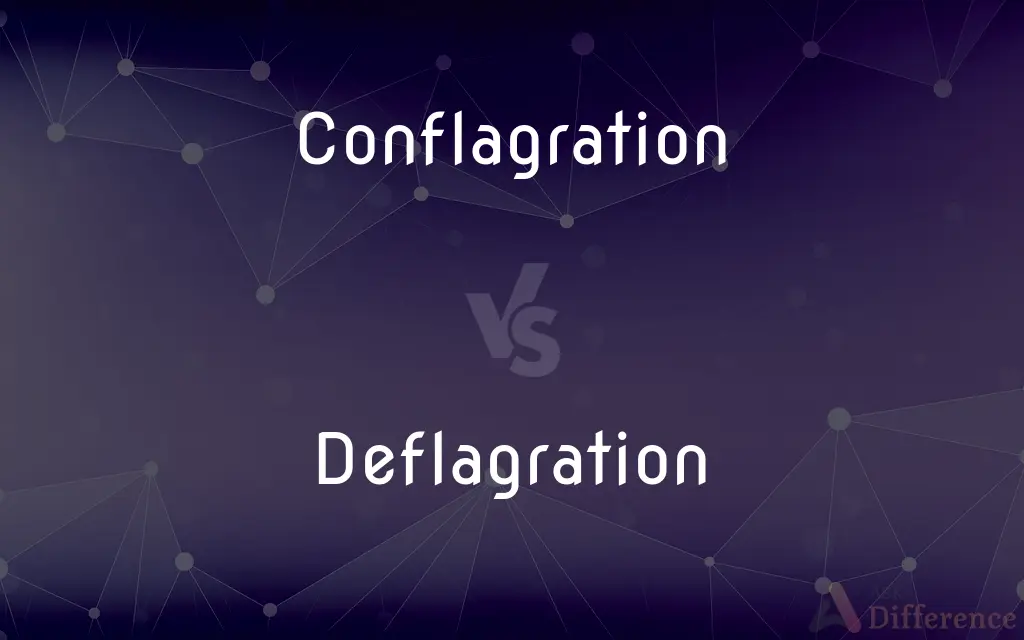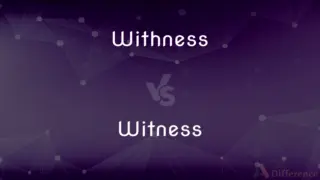Conflagration vs. Deflagration — What's the Difference?
Edited by Tayyaba Rehman — By Maham Liaqat — Updated on March 14, 2024
Conflagration refers to a large, destructive fire that spreads rapidly, while deflagration describes a process of combustion that spreads through a gas or across the surface of an explosive at subsonic speeds.

Difference Between Conflagration and Deflagration
Table of Contents
ADVERTISEMENT
Key Differences
Conflagration typically denotes an extensive and uncontrolled fire, often resulting in significant damage and destruction over a wide area. These fires can be fueled by various materials and are characterized by their rapid spread and intensity. On the other hand, deflagration is a technical term used primarily in the context of combustion and explosives, referring to a mode of burning in which the flame front moves through the unburned fuel at a speed less than the speed of sound in the unreacted medium.
While conflagrations are often discussed in the context of wildfires, urban fires, or large-scale incidents causing widespread damage, deflagrations are more specific to the field of chemistry and pyrotechnics, describing a particular kind of rapid but subsonic combustion. This distinction points to the broader applicability of the term "conflagration" in various contexts, as opposed to the more specialized use of "deflagration."
The consequences of a conflagration, such as loss of life, destruction of property, and environmental damage, are typically more severe and visible compared to a deflagration, which might be contained or controlled in a laboratory or industrial setting. However, deflagrations can also pose significant risks, especially in scenarios involving explosive materials or confined spaces where the rapid spread of combustion can lead to explosions.
Understanding the difference between conflagration and deflagration is crucial for professionals in fields such as firefighting, emergency management, and explosives engineering. While both terms deal with rapid combustion, the scale, context, and potential hazards differ significantly.
In essence, conflagration emphasizes the scale and impact of a fire, often involving large areas and high levels of destruction, whereas deflagration focuses on the nature and speed of combustion, particularly in the context of explosive materials and reactions.
ADVERTISEMENT
Comparison Chart
Definition
A large, destructive fire spreading rapidly.
Combustion spreading subsonically through gas or surface of explosives.
Context
Wildfires, urban fires, large-scale incidents.
Chemistry, pyrotechnics, explosives.
Spread
Rapid and extensive across large areas.
Rapid but subsonic, often confined.
Consequences
Significant destruction, loss of life, environmental impact.
Can lead to explosions, primarily in controlled settings.
Application
Broad, across various scenarios of massive fires.
Specialized, in the context of combustion and explosives.
Compare with Definitions
Conflagration
Conflagrations are characterized by their large scale and rapid spread, consuming vast areas.
The conflagration engulfed the entire forest, leaving a path of destruction.
Deflagration
Deflagration involves combustion that spreads through a material at subsonic speeds.
The deflagration of the powder was observed in a controlled laboratory environment.
Conflagration
The speed at which a conflagration spreads is a defining feature, driven by wind, fuel, and other conditions.
Fueled by strong winds, the conflagration spread faster than firefighters could respond.
Deflagration
Deflagration is a key concept in the study and handling of explosives, emphasizing the speed of the reaction.
The deflagration of the compound was initiated in a secure testing facility.
Conflagration
These fires often result in substantial property damage and can lead to loss of life.
The city was devastated by a conflagration that razed entire neighborhoods.
Deflagration
In certain conditions, deflagration can lead to more violent explosions, posing significant risks.
The deflagration of the gas in the confined space created a risk of a more powerful explosion.
Conflagration
Conflagrations can be sparked by natural causes like lightning or human activities such as arson.
A discarded cigarette was all it took to start a conflagration in the dry grasslands.
Deflagration
Unlike widespread conflagrations, deflagrations can be controlled or contained, especially in experiments or industrial applications.
Safety measures were in place to contain the deflagration within the designated area.
Conflagration
Managing a conflagration requires a coordinated emergency response to mitigate damage and protect lives.
Emergency teams from neighboring regions converged to combat the sprawling conflagration.
Deflagration
This term is often used in specialized fields related to explosives and chemical reactions.
Experts in pyrotechnics understand the precise conditions under which a deflagration can occur.
Conflagration
A conflagration is a large and destructive fire that threatens human life, animal life, health, and/or property. It may also be described as a blaze or simply a (large) fire.
Deflagration
Deflagration (Lat: de + flagrare, "to burn down") is subsonic combustion in which a pre-mixed flame propagates through a mixture of fuel and oxidizer. Deflagrations can only occur in pre-mixed fuels.
Conflagration
A large destructive fire.
Deflagration
To burn or cause to burn with great heat and intense light.
Conflagration
A large fire extending to many objects, or over a large space; a general burning.
It took sixty firefighters to put out the conflagration.
Deflagration
The act of deflagrating; an intense fire; a conflagration or explosion. Specifically, combustion that spreads subsonically via thermal conduction.
Conflagration
(figuratively) A large-scale conflict.
Deflagration
A burning up; conflagration.
Conflagration
A fire extending to many objects, or over a large space; a general burning.
Till one wide conflagration swallows all.
Deflagration
The act or process of deflagrating.
Conflagration
A very intense and uncontrolled fire
Deflagration
Combustion that propagates through a gas or along the surface of an explosive at a rapid rate driven by the transfer of heat
Common Curiosities
What differentiates a conflagration from a regular fire?
A conflagration is differentiated by its large scale, rapid spread, and the significant damage it causes, beyond what is typical of smaller, more contained fires.
Can a deflagration turn into a conflagration?
In specific circumstances, such as a deflagration in a large enough quantity of explosive material leading to widespread fire, it could escalate into a conflagration, but these terms generally describe distinct phenomena.
Are all explosions the result of deflagration?
Not all explosions are the result of deflagration; some result from detonation, which is a different process involving supersonic shock waves that drive the reaction.
What safety measures are important for handling materials prone to deflagration?
Safety measures include proper storage, handling procedures, containment systems, and emergency plans to manage and mitigate the risks associated with deflagrations.
Can deflagration occur in both open and confined spaces?
While deflagration can occur in both open and confined spaces, its consequences and the risk of subsequent explosion can be significantly greater in confined spaces due to pressure buildup.
What are some historical examples of conflagrations?
Historical examples include the Great Fire of London in 1666 and the Chicago Fire of 1871, both of which resulted in extensive damage and are remembered for their impact on fire safety regulations.
What role does the environment play in the spread of a conflagration?
Environmental factors like temperature, humidity, wind, and the availability of combustible materials significantly influence the initiation and spread of a conflagration.
How does the speed of deflagration compare to the speed of sound?
Deflagration involves combustion that spreads at subsonic speeds, meaning the flame front moves slower than the speed of sound in the unreacted material.
What are the environmental impacts of a conflagration?
Conflagrations can have severe environmental impacts, including air pollution, habitat destruction, and changes to the landscape that can affect ecosystems for years.
How are conflagrations prevented or controlled?
Conflagrations are prevented or controlled through firebreaks, controlled burns, building codes, and rapid emergency response to contain and extinguish fires before they can spread widely.
Is deflagration a common term in everyday language?
Deflagration is more of a technical term used in specialized fields such as chemistry, pyrotechnics, and explosive engineering, and is not commonly used in everyday language.
How is the speed of a deflagration flame front measured?
The speed of a deflagration flame front is typically measured using high-speed photography, pressure sensors, and other specialized instrumentation in controlled environments.
Can deflagration be intentionally used in industrial applications?
Yes, deflagration can be intentionally used in controlled industrial processes, such as in the combustion engines or in the controlled burning of waste gases.
How do emergency services prepare for and respond to conflagrations?
Emergency services prepare for conflagrations through training, planning, resource allocation, and community education to ensure rapid and effective response to large-scale fires.
What research is being done to better understand and control deflagrations and conflagrations?
Research in these areas includes studying the physics and chemistry of combustion, developing new materials and technologies for fire prevention and suppression, and improving predictive models to prevent and manage large-scale fires.
Share Your Discovery

Previous Comparison
Withness vs. Witness
Next Comparison
Jinx vs. WitchAuthor Spotlight
Written by
Maham LiaqatEdited by
Tayyaba RehmanTayyaba Rehman is a distinguished writer, currently serving as a primary contributor to askdifference.com. As a researcher in semantics and etymology, Tayyaba's passion for the complexity of languages and their distinctions has found a perfect home on the platform. Tayyaba delves into the intricacies of language, distinguishing between commonly confused words and phrases, thereby providing clarity for readers worldwide.














































